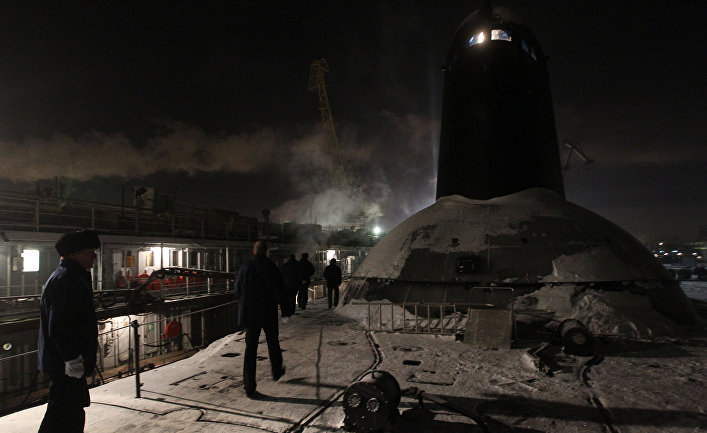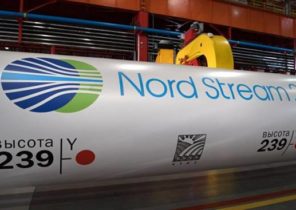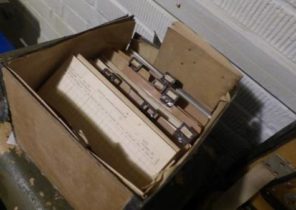
World’s biggest submarines were built in American shipyards, and in the Soviet shipyards. These leviathans of the cold war could destroy up to 200 targets warheads, which was six times more powerful than the bomb exploded over Hiroshima. Submarine class “Shark” became one of the most fearsome weapons in history.
Shark, or submarine of project 941, as it was called during development, was to be the basis of the Soviet nuclear deterrent force at sea. The Soviet Union learned of the U.S. building a fleet of nuclear submarines submarines of the “Ohio” with a length of 172 meters and with 192 nuclear warheads. The Soviet leadership decided that the country needs a submarine as a response to the looming threat. Thus was born the submarine “Akula”.
“Shark” was intended for launching missiles from a short distance from the Soviet Union, which allowed it to operate North of the Arctic circle, where it could protect the Soviet air force and Navy. So the boat was built with a reinforced hull to break through a solid polar ice. She had a large reserve buoyancy to float the ice and a couple ice-protected propellers.
Another result of this development was a new missile R-39 in the nuclear warheads, have sufficient range to strike the United States from the Arctic bastions. It was a huge three-stage ballistic missile is 16 meters long, weighed 48 tons. Having a launch range of 8,300 kilometers, P-39 could hit any target in the continental United States.
The arms race during the cold war was primarily a contest, and the counting of warheads was of great importance. The “Sharks” was only 20 missiles, while “Ohio” 24, and therefore every Soviet rocket was supposed to carry more nuclear warheads than the us, “Trident C-4”. One missile R-39 was 10 warheads capacity of 100 kilotons, and each had individual guidance, whereby one missile could hit 10 different targets at a small distance from each other. This has led to an increase in the size and weight of the missile, but ultimately each Shark was armed with 200 warheads — eight more than Ohio.
Boat length was 173 meters, that is, she was only a meter longer than an American missile. Width “Ohio” is 13 meters, while the “Sharks” it is astounding 23 meters. It is necessary for the deployment of missiles and providing a large reserve of buoyancy. As a result on light there was a boat with a displacement of 48 thousand tons, which is twice the displacement of the submarine “Ohio”.
The R-39 was placed in two rows of 10 silos each. Unlike other submarines, mines were placed in front of the wheelhouse, from which the “Shark” has such an unusual appearance. This gigantic submarine could reach a surface speed of 22 knots, and under water 27 knots, which was provided by two nuclear reactors OKB-650. They created a total shaft power of almost 100 thousand horsepower.
Total planned to build eight “Sharks”, but managed to create only six. They were inherited by the Russian Navy after the cold war. Today is to build only one submarine “Dmitry Donskoy”, and the fate of two more in limbo. “Dmitry Donskoy” is used in the framework of testing the latest missile 3M14 Bulava. “Bulava” was born long and in great anguish, but it looks like work is being completed, and therefore the boat can soon be written off.
The existence of submarines of project 941 “Akula” few people knew. They would not have received wide recognition, if not for the novel “the Hunt for Red October”. This book was published in 1984, becoming the debut work of the enthusiast of military Affairs and insurance agent Tom Clancy (Tom Clancy). Clancy described a modified submarine project “Shark” called “Red October”, whose disillusioned with the Soviet system, the commander and the crew tried to flee to the United States.
“Red October” was more the standard “Sharks”, with 26 rocket launchers instead of 20. It was also equipped with low noise water-jet propulsion system theoretically allows you, as the author writes, quietly come to the East coast of the United States and deal a crippling “decapitation strike” that destroyed Washington. In the novel “Red October” appears as a first strike weapon. The author called the boat technical treasure which longed to lay hands the United States Navy.
Since the release of the book took place 32 years and water-jet thrusters are used today in submarines all over the world. They are fitted to the British submarine type “Astute” and the American percussion submarine type “Virginia”. Such thrusters used on the Russian submarines of “Borey”, which was created after the cold war and largely became preednisone “Shark.” This is another example of how fiction becomes reality.
Kyle Mizokami is a specialist in the field of defense and national security. Lives and works in San Francisco, and his articles are published in such publications as the Diplomat, Foreign Policy, War is Boring and the Daily Beast. In 2009, he became one of the founders of the blog Japan Security Watch.







